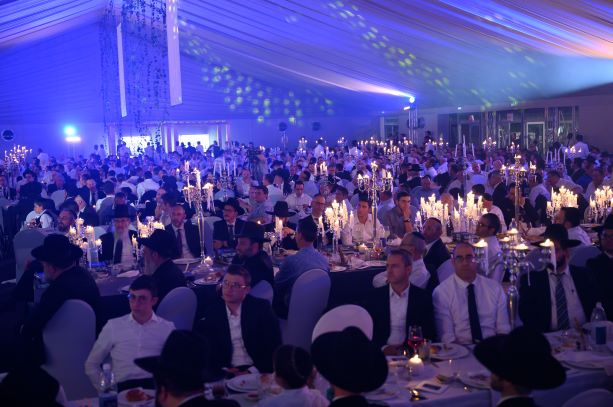click to dowload our latest edition
CLICK HERE TO SUBSCRIBE TO OUR NEWSLETTER


Published
4 years agoon
By
adminJORDAN MOSHE
The lavish banquet dinner and celebration was held at the deck on this hallowed sportsground in honour of South Africans reaching an international landmark.
Known as the Dirshu World Siyum, the dinner celebrated the success of a seven and a half-year long daily commitment to completing the Talmud, an undertaking by 60 South African Jews.
Their commitment was to study one page of the Gemara every single day. This is known as Daf Yomi. Their achievement was celebrated alongside the broader Torah accomplishments of Johannesburg Jewry. Dirshu, an international organisation whose goal is to strengthen and encourage Torah study throughout the diaspora, organised the event.
“Tonight is a small glimpse of the truth,” said Rabbi Ari Taback, the director of Dirshu South Africa. “Take a mental snapshot of what’s around you tonight. We are celebrating a sublime achievement. The next time you see a five-year-old mouthing the words of the alef bet (Hebrew alphabet), remember this celebration. This is what matters.”
Extolling the achievements of the community, South African Chief Rabbi Dr Warren Goldstein recalled the faith the late Rabbi Yitzchak Kossowsky had in South African Jewry. Kossowsky came from Lithuania to Johannesburg in 1933 to take up the position of head of the Beth Din, in which he served until he died in 1951.
“In the years of Kossowsky’s tenure, the state of Torah learning in Johannesburg was deteriorating fast. An article was published in 1937 in which Rav Kossowsky was asked whether there was any chance for the survival of Torah in South Africa. At the time, there was very little precedent. Yet amidst pervasive weakening of mitzvot (good deeds) and drifting away from Torah, he passionately asserted with no tangible evidence that Torah would ultimately return to South African Jews,” Goldstein told the crowd.
“Think what Rav Kossowsky would say if he were to walk into this hall tonight, with more than 1 200 people present and many more wanting to come. What would he say to the fact that learning of Gemara has been revived? What would he say about his precious community that has been completely transformed and returned to Torah in such unprecedented numbers?
“It doesn’t matter what kind of a Jew you are, we celebrate and learn the same Torah. We grow in this community, and that’s a gift. We must take strength from vibrancy and growth, from passion for Torah. Tonight symbolises all of that. It’s a vision of a vibrant future for our community, one deeply rooted in Torah and mitzvot,” the chief rabbi said.
Rabbi Dovid Hofstedter, Dirshu’s founder and director, lauded the community for maintaining its Torah inheritance.
“This community has defied all the odds and come together as one,” he said. “It celebrates Torah. The Torah is our inheritance and legacy, so one would think that it should be received automatically. Pirkei Avot, however, says that it isn’t so, that you have to work to earn it,” said Hofstedter.
“Look around the world today. The Torah is being celebrated with honour that is unprecedented in the history of our exile. This is an unprecedented celebration of learning just 75 years after the Holocaust. Torah is the air we breathe, and Jews can’t exist without it. We yearn for the transformative experience it offers, and we become different people because of it,” Hofstedter said.
“This Siyum shows that Torah is what we are yearning for, that it’s our life. We want transformation. We want to elevate ourselves and our nation.”
The evening’s keynote speaker, Rabbi Paysach Krohn, stressed that Torah was relevant to every Jew’s life, and used a remarkable story to illustrate the point.
“In 1994, the German government allowed the Jews to build a memorial in downtown Berlin,” recounted this international Torah-related speaker and author. “It gave them four acres of land on which to build a memorial to Europe’s Jews. A total of 200 different artists competed, and the judges selected Peter Eisenman’s design.” Krohn said Eisenman’s design featured 400 slabs of blank stone without any inscriptions whatsoever, collectively representing all kinds of Jews who had perished anonymously.
However, an unexpected issue arose. “Just before construction began, Germany passed a new law, ruling that memorials had to be built with wheelchair access,” said Krohn. “That changed things, because Eisenman had designed the stones to be near one another. Many stones had to be removed to create space for wheelchairs, and the design changed considerably.”
As a result, 2 711 stones were placed, the exact number of pages in the Talmud. Said Krohn, “Every page of Shas is therefore represented in Berlin, and this relates to our lives as well. The Talmud represents our experiences. It is made up of chapters; some longer, some shorter, some more difficult than others. This is mirrored in our daily lives exactly.”
Krohn emphasised the need to make learning a priority.
“When the founder of Daf Yomi, Rabbi Meir Shapiro, was nine, his mother made sure that he had daily lessons with a tutor. One day they moved, and little Meir’s mother communicated their new address to the tutor. Somehow, he didn’t get the message, and by 21:00 that night, she realised the tutor wasn’t coming,” Krohn said.
“She sat down and started crying. When Rav Meir asked her why, she told him words he never forgot: ‘A day of learning lost is gone forever. You cannot make it up.’ That’s why he proposed the idea of a Daf Yomi at the age of 36. The project became a reality only because of a mother’s belief that a day of learning can’t be regained.
“Tonight, every one of us needs to remember three things: consistency, tenacity, and daily dedication. That’s how you accomplish things. We need to recognise that Torah learning brings serenity, that Torah study is essential, and that such accomplishments are deserving of special celebration.”
